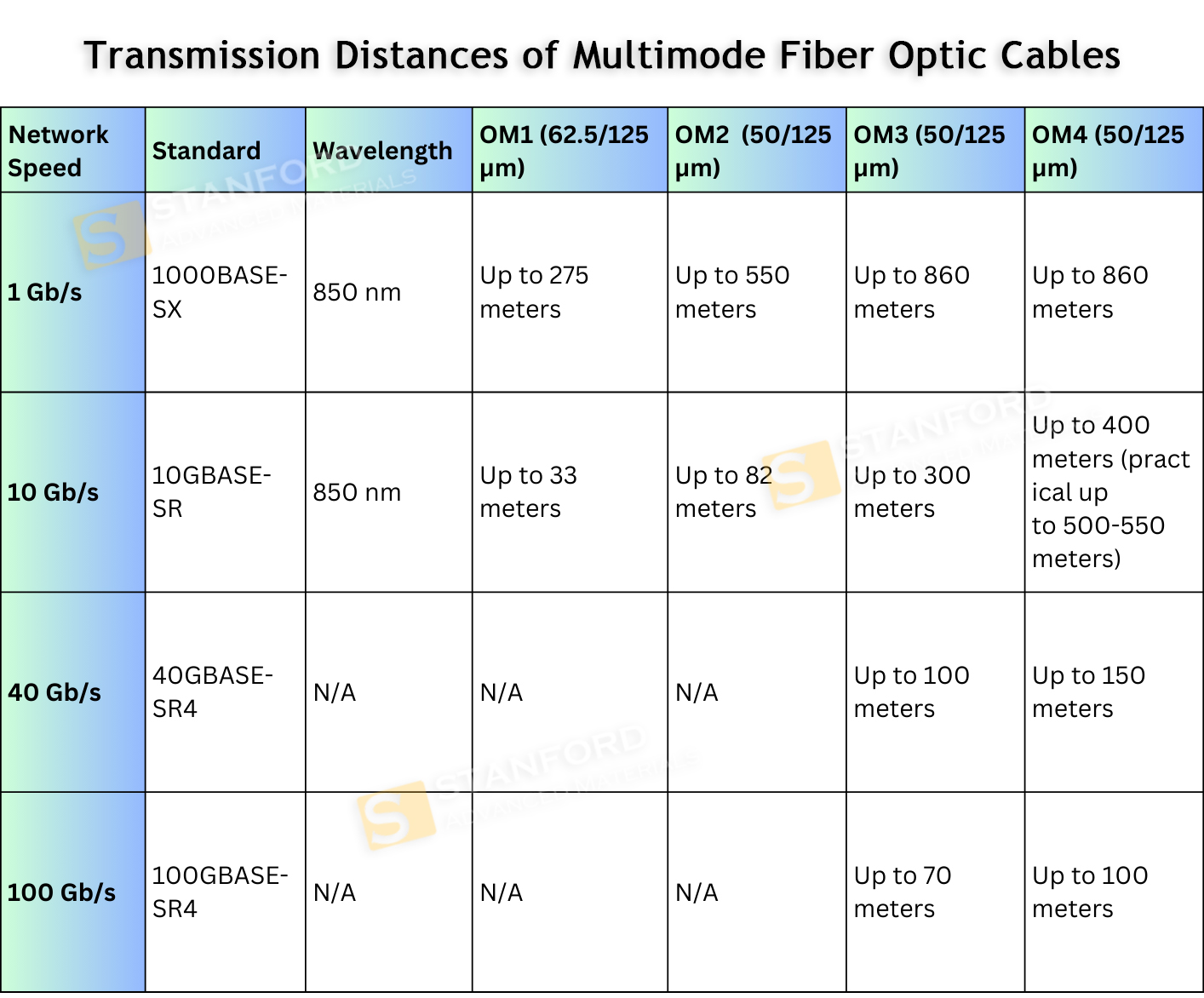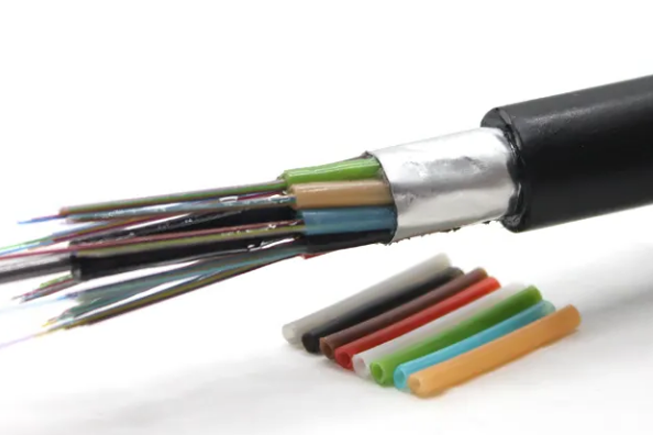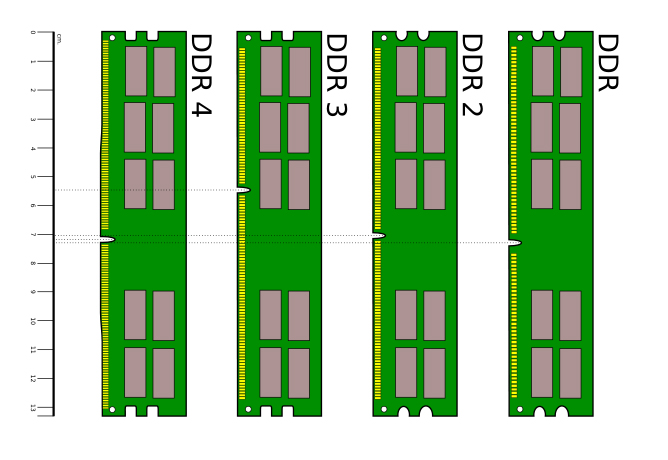
How Far Can Multimode Fiber Optic Cables Transmit?
Multimode fiber optic cables are designed to carry multiple light modes simultaneously, each taking a different path or mode through the fiber. This characteristic makes MMF ideal for high-bandwidth applications over relatively short distances. Common applications include Local Area Networks (LANs), data centers, and enterprise network infrastructures.
In contrast, single-mode fibers support only a single light mode, allowing for longer transmission distances and higher bandwidths. The fundamental differences between MMF and SMF lie in their core diameters and the light sources used. While MMF typically has a core diameter ranging from 50 to 62.5 microns, SMF cores are much smaller, around 8 to 10 microns, enabling precise light propagation with reduced signal dispersion.
This article aims to:
- Explore the distance limitations of multimode fibers across various transmission speeds.
- Analyze the key factors that influence the effective transmission distance of MMF.
- Guide on optimizing MMF performance in real-world applications.
For an in-depth comparison between multimode and single-mode fibers, please refer to our detailed Multimode vs. Single-Mode Fiber Comparison article.
1. Transmission Distance Limitations at Different Speeds
The transmission distance of multimode fibers varies significantly based on the data rate and the specific fiber type used. Here, we examine the limitations across common transmission speeds and standards.
1.1 1 Gb/s Networks
1000BASE-SX Standard
The 1000BASE-SX standard is widely used for Gigabit Ethernet over short to medium distances using multimode fiber. It operates at a wavelength of 850 nm and is optimized for short-range data transmission.
Maximum Transmission Distances for Various Multimode Fibers
-
- OM1 (62.5/125 µm): Up to 275 meters
- OM2 (50/125 µm): Up to 550 meters
- OM3/OM4 (50/125 µm): Up to 860 meters
These distances are sufficient for most LAN and data center applications, where the physical infrastructure often spans within these ranges.
Alternatives with Single-Mode Fiber
While MMF is cost-effective for shorter distances, single-mode fiber becomes a viable alternative for environments requiring longer reach and higher bandwidth flexibility. SMF can extend transmission distances well beyond what MMF offers at similar data rates.
1.2 10 Gb/s Networks
10GBASE-SR Standard
The 10GBASE-SR standard caters to 10 Gigabit Ethernet over multimode fiber. Operating at 850 nm, it leverages the high bandwidth capabilities of MMF to achieve higher data rates.
Transmission Limitations for Various Multimode Fibers
-
- OM1: Up to 33 meters
- OM2: Up to 82 meters
- OM3: Up to 300 meters
- OM4: Up to 400 meters (with practical reach up to 500-550 meters)
Impact of Optical Source Types on Transmission Distances
The type of optical source—LEDs or Vertical-Cavity Surface-Emitting Lasers (VCSELs)—significantly influences transmission distances. VCSELs, with their narrow spectral width, reduce modal dispersion, thereby enhancing the effective transmission distance compared to LED sources.
1.3 40 Gb/s Networks
40GBASE-SR4 Standard
The 40GBASE-SR4 standard supports 40 Gigabit Ethernet over multimode fiber, primarily used in high-performance data centers requiring substantial bandwidth.
Transmission Distance Limits
-
- OM3: Up to 100 meters
- OM4: Up to 150 meters
Differences in Applications Between Data Centers and Enterprise Networks
In data centers, where high-density and short-reach connections are prevalent, OM3 and OM4 fibers are optimal choices. Conversely, enterprise networks might require different considerations based on the infrastructure and distance requirements.
1.4 100 Gb/s Networks
100GBASE-SR4 Standard
100GBASE-SR4 is designed for 100 Gigabit Ethernet over multimode fiber, supporting high-speed data transmission in environments like large-scale data centers.
Transmission Distances
-
- OM3: Up to 70 meters
- OM4: Up to 100 meters
Advantages of Single-Mode Fibers at High Transmission Speeds
At such high data rates, single-mode fibers offer significant advantages in terms of transmission distance and bandwidth scalability. SMF can support 100 Gb/s and beyond over much longer distances without the modal dispersion challenges inherent to MMF.

2. Factors Affecting the Transmission Distance of Multimode Fibers
Several factors influence how far multimode fibers can effectively transmit data. Understanding these can aid in optimizing network performance and planning infrastructure.
Bandwidth-Length Product (BWL)
Definition and Role in Multimode Fibers
The Bandwidth-Length Product (BWL) quantifies the performance capability of a fiber, representing the product of the bandwidth and the maximum length over which that bandwidth can be maintained. In MMF, a higher BWL indicates better performance, allowing for higher data rates over longer distances.
Modal Dispersion
Impact on Signal Quality
Modal dispersion occurs when different light modes travel at varying speeds, causing signal spreading and potential overlap. This dispersion limits the effective transmission distance and can degrade signal quality, especially at higher data rates.
Type of Optical Source
LED vs. Laser (VCSEL)
-
- LEDs: Emit light over a broad range of wavelengths, increasing modal dispersion and limiting transmission distances.
- VCSELs: Produce a more concentrated wavelength distribution, reducing modal dispersion and allowing for longer transmission distances and higher data rates.
Environmental Factors
Temperature, Cable Bending, Contamination, etc.
Environmental conditions can adversely affect fiber performance:
-
- Temperature: Extreme temperatures can cause expansion or contraction of fibers, impacting signal transmission.
- Cable Bending: Sharp bends can cause signal attenuation and increased modal dispersion.
- Contamination: Dirt and dust on connectors can lead to signal loss and reduced transmission efficiency.
Fiber Quality and Manufacturing Process
The quality of the fiber and the precision of the manufacturing process play crucial roles in determining transmission distance. Defects, impurities, and inconsistencies can introduce additional losses and dispersion, limiting the effective reach of the fiber.
3. Choosing Between Multimode and Single-Mode Fibers
While this article focuses on multimode fibers, choosing between MMF and SMF is a critical decision based on specific network requirements.
Basic Differences
-
- Transmission Mode: MMF supports multiple light modes; SMF supports only a single mode.
- Core Diameter: MMF typically has a larger core (50-62.5 µm) compared to SMF (8-10 µm).
- Distance and Bandwidth: SMF offers longer distances and higher bandwidths.
Overview of Selection Factors
-
- Cost: MMF generally has lower initial costs but may require more active components for longer distances.
- Transmission Distance: SMF is preferable for longer distances, while MMF suits shorter runs.
- Bandwidth Requirements: High-bandwidth applications may benefit from SMF's superior performance over distances.
For a comprehensive comparison, refer to our article on Multimode vs. Single-Mode Fiber Comparison.
4. Optimization Strategies in Practical Applications
To maximize the performance and transmission distance of multimode fibers, consider the following optimization strategies:
Correct Selection of Fiber Type
Choose the appropriate fiber type (OM1, OM2, OM3, OM4) based on your network's data rate and distance requirements. Higher-grade fibers like OM3 and OM4 support higher bandwidths and longer distances, making them suitable for future-proofing your network infrastructure.
Optimizing Fiber Cabling
Ensure proper installation practices, including minimal bending radii, adequate slack for future maintenance, and avoiding physical stress on fibers. Proper cabling techniques prevent signal loss and maintain transmission integrity.
Maintenance and Management
Regularly clean fiber connectors and inspect fibers for damage or contamination. Clean connectors ensure optimal signal transmission and reduce the risk of attenuation and dispersion.
Compatibility with Equipment
Use transceivers and optical modules that are compatible with your chosen fiber type and grade. Mismatched components can lead to suboptimal performance, increased errors, and reduced transmission distances.
Conclusion
Multimode fiber optic cables offer a cost-effective solution for high-bandwidth, short to medium-distance applications commonly found in LANs and data centers. Understanding the transmission distance limitations across various data rates, alongside the factors influencing performance, is essential for optimizing network design and ensuring reliable communication.
While multimode fibers are advantageous for many scenarios, single-mode fibers provide superior performance for longer distances and higher bandwidth requirements. As network demands continue to grow, selecting the appropriate fiber type and implementing best practices in installation and maintenance will ensure robust and scalable communication infrastructures.
If you are searching for high-quality multimode fiber optic cables to meet various networking needs, Stanford Optics is your ideal choice. As an industry-leading provider of fiber optic solutions, we offer a wide range of multimode fiber cables, including but not limited to OM1, OM2, OM3, and OM4 cables, suitable for network speeds ranging from 1 Gb/s to 100 Gb/s. The company is dedicated to delivering premium, reliable products to ensure your data transmission is efficient and stable.




